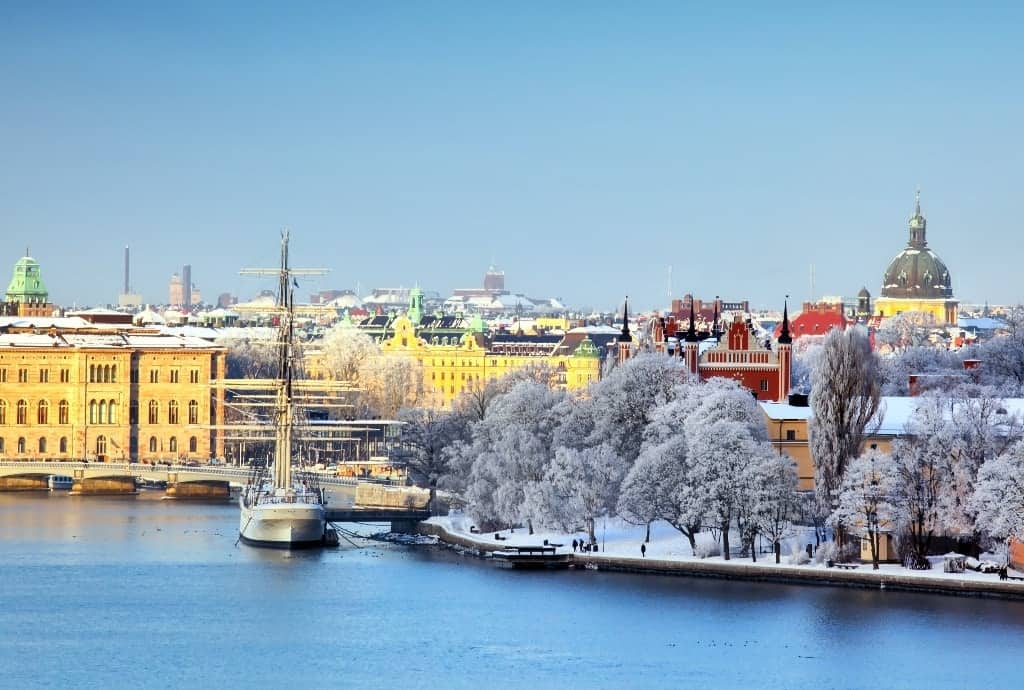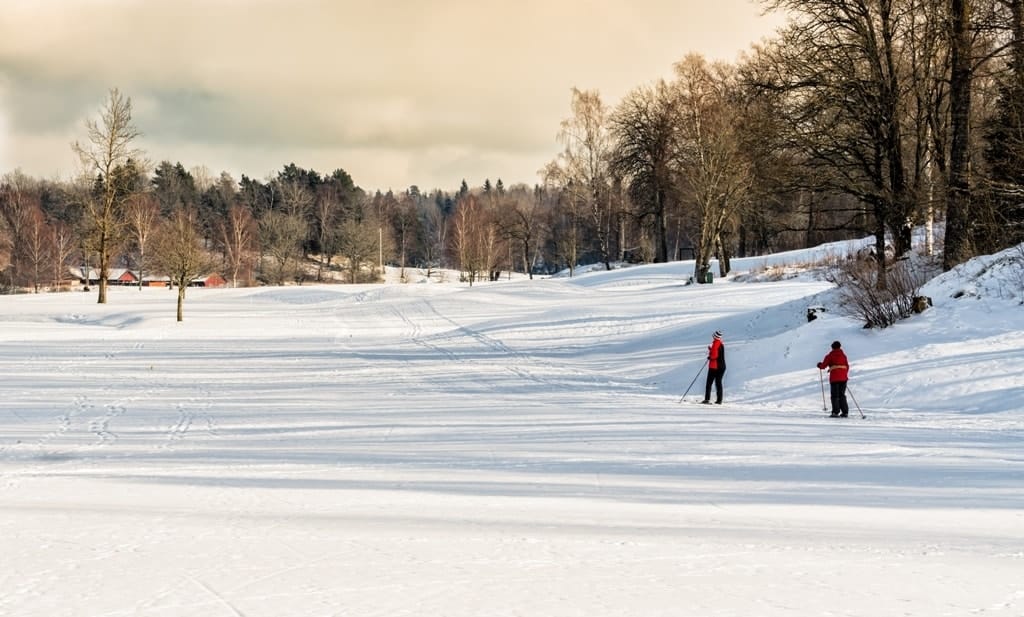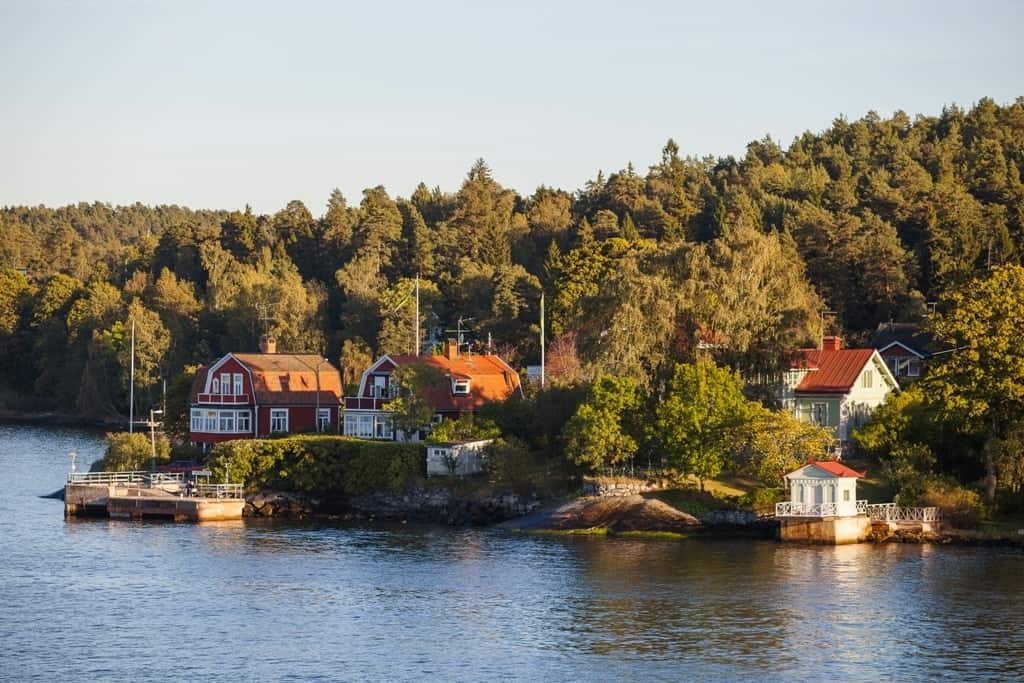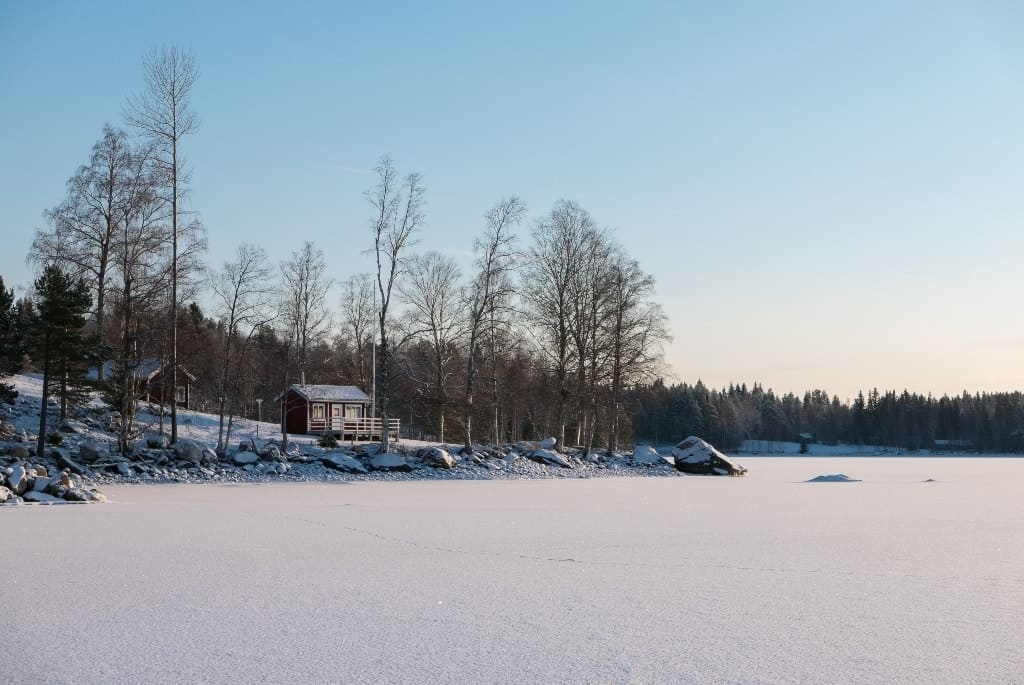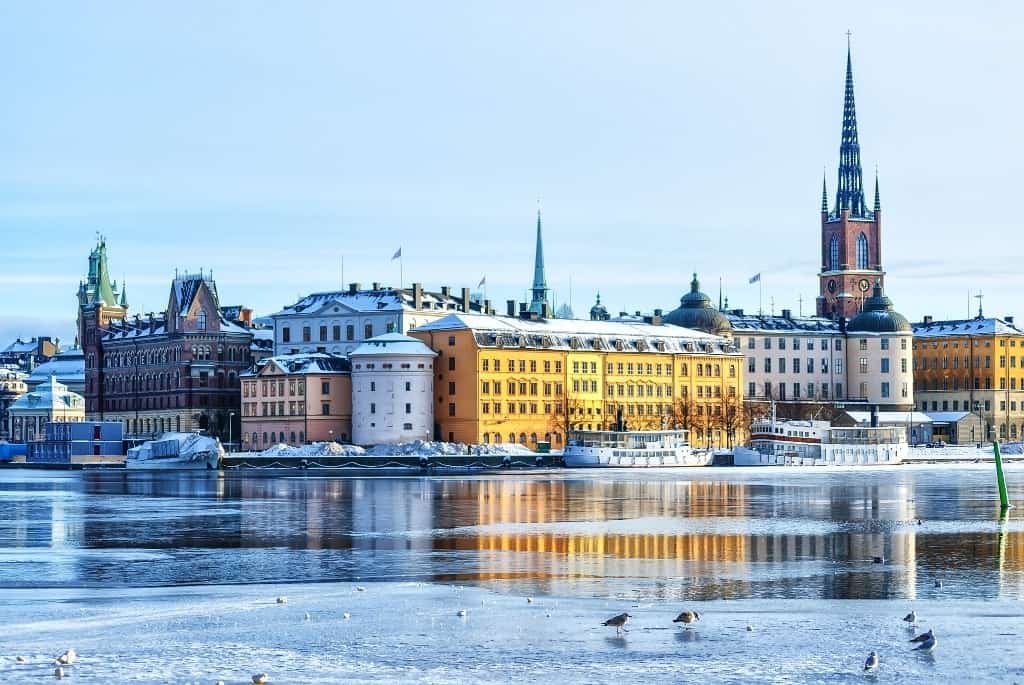This post is also available in: French
Stockholm is stunning throughout the year, however, particularly for anyone visiting from more southerly locations, Sweden’s capital is a winter wonderland. The city stands on 14 of the roughly 30,000 islands that make up the Stockholm archipelago. In winter, the water that surrounds the city freezes over and snow dusts the rocky hilltops of Södermalm (the south island) like a scene straight from a Christmas card. As well as being picturesque, the city offers a variety of wonderful things to do during winter. It is also the best time of year to get an authentic taste of Stockholm life, as in summer many of the locals head to their summer houses in the archipelago, leaving the city to the tourists.
Table of Contents
Stockholm in winter: weather and daylight hours
Winter in Sweden officially begins when the average temperature for the day is 0˚C or below, for five days in a row, and ends when the average daily temperature once again rises above 0˚C, for seven days in a row (according to Sweden’s weather agency, SMHI). In Stockholm, this is usually between early December and mid-March. During these months the average temperature is just below 0˚C, however there can be days where it drops to -15˚C. While snow sometimes arrives as early as October, it isn’t always guaranteed, so for a better chance of experiencing the city in a blanket of white, it’s best to visit in January or February.
Towards the end of the year Stockholm gets about six hours of daylight, with the sun rising at around 8:45 am and setting just before 3 pm. By the end of February, however, the number of daylight hours increases to roughly 10 hours a day. Swedes fend off the darkness with a plethora of fairy lights and candles, lighting up every window and doorway with a welcoming glow.
Disclaimer: This post contains affiliate links. This means that should you click on certain links, and then subsequently purchase a product, I will receive a small commission.
Things to do during winter in Stockholm
Christmas markets and New Year’s Eve fireworks
Christmas in Stockholm is magical as the city is decorated with advent candles, stars, Yule goats (“julbock” – straw goats with their origins in pagan celebrations) and Christmas gnomes (“tomte” – a kind of Scandinavian Santa Claus). Stockholm is also home to what is said to be one of the tallest real Christmas trees in the world. At around 40 metres high and adorned with 5,000 lights, it is a Christmas sight worth seeing. Located at Skeppsbron, near the royal palace, it’s easy to drop by on route to the Gamla Stan Christmas market. Gamla Stan, meaning “the old town”, is a must see for any visitor to Stockholm, with it’s narrow, cobbled streets and old-world charm. At the centre lies the town square and, for most of December, one of thebusiest Christmas markets around. The wooden stalls offer a range of traditional foods and handicrafts, which make charming gifts for friends and family.
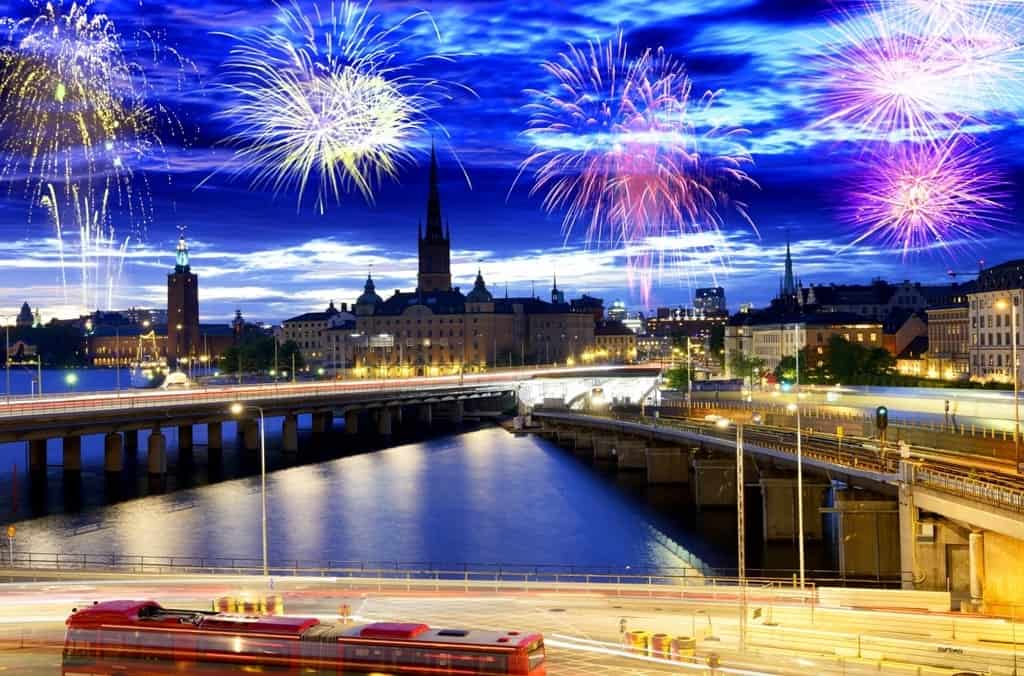
Another excellent Christmas market and all-around fun day out can be found at Skansen, the world’s oldest open-air museum, which showcases the history of Sweden through its original buildings and farms. Christmas at Skansen is celebrated by dancing around the Christmas tree in the town square, live music, and craft demonstrations. Skansen also has a zoo, with many Nordic animals such as wolves, lynx, and reindeer. Additionally, there is a children’s petting zoo and a large aquarium, including the World of Monkeys, which contains around 200 exotic species. New Year’s Eve celebrations at Skansen include a reading of Lord Tennyson’s poem “Ring out wild bells” on the main stage at midnight and Skansen’s location on top of a hill overlooking Stockholm provides perfect views of the city’s firework display, while a glass of champagne can be enjoyed from one of several on-site bars. Other places with great views of the fireworks include Skinnarviksberget, the city’s highest natural viewpoint, and two of the city’s main bridges, Västerbronand Skanstullsbron.
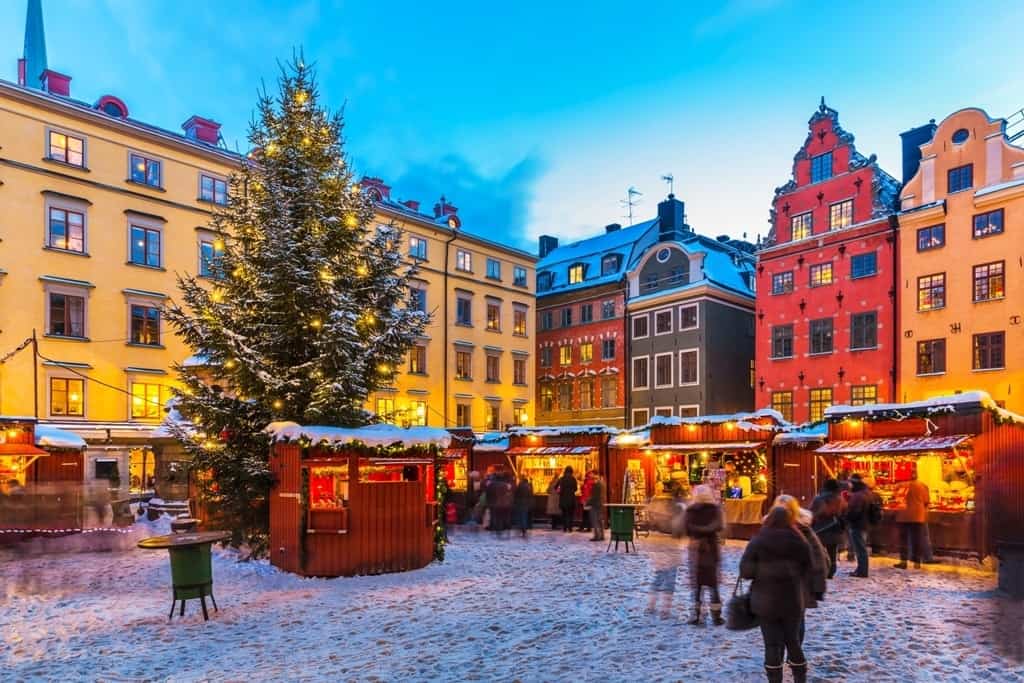
Skiing, skating and saunas
Swedes are active people and the weather doesn’t stop them. In winter, when the lakes freeze over, skating is a popular activity and there are several outdoor skating rinks in Stockholm. At the ice rink in Kungsträdgården, a large central park, skates are available to hire, lively music plays and there are also plenty of bars, restaurants, and shops in the surrounding area to explore. There are often other events going on in Kungsträdgården too, such as festivals of food, culture, and art. For people who want to get off the ice rink and out onto the frozen water, it is possible to skate both on the inner-city lakes as well as further out into the archipelago. Skating on natural ice can be dangerous, so it’s highly recommended to book a tour and go with an experienced guide who will have safety equipment and knowledge of the local conditions. Lessons for beginners are also available for those with little or no skating experience.
Downhill and cross-country skiing are also common winter activities, once the snow has arrived. Downhill skiing can be enjoyed at Hammarbybacken, which has a blue, red and black run and is easily accessible by public transport from central Stockholm. While Hellasgården, also close to the city centre, is popular for cross-country skiing. For a really Swedish experience, at Hellasgården it is possible to take a sauna before cooling off by jumping into the freezing lake, with a hole in the ice kept open during the winter for this very reason.
Getting into nature
There are also many ways to enjoy the beautiful winter scenery at a calmer pace. Stockholm itself is a beautiful place to just stroll around, with each island having its own character. However, there are several places to escape the bustle of urban life. Vinterviken, in south Stockholm, is a bay surrounded by cliffs and trees. It is here Alfred Nobel had his research laboratory and dynamite factory and is now a well-liked area for walks and relaxing. There is also a cafe serving light lunches and home-made baked goods. To experience Swedish nature further, just a 40-minute bus journey outside of the city center is Tyresta National Park, which has 55km of hiking trails through the unspoiled countryside, including forest, lakes and shoreline cliffs.
Click here for more information and to book a hike.
Exploring the archipelago
The archipelago is one of Stockholm’s best features and, while much of it freezes over in the winter, there are several routes that are kept open, making a boat trip essential. Winter archipelago boat tours last a few hours and include a tour guide to provide fun facts and stories about the islands. The boats have indoor and outdoor areas and wrapping up warm before heading out onto the deck is a good idea. It’s also possible to combine a boat tour with lunch; a great time saver with a luxurious feel.
Click here for more information and to book an archipelago cruise with a guide.
For those with more time to spare, there are many islands further out in the archipelago that are accessible during the winter months. Fjäderholmarna and Vaxholm are the closest islands to the city center and can be easily visited in a day. However, for a night away from the city, Finnhamn, Sandhamn, and Svartsö are great options. In winter, Finnhamn is incredibly peaceful and tranquil, there is not a lot to do there, but it is a lovely place to disconnect and enjoy nature. Sandhamn is one of the furthest islands out in the archipelago and is inhabited all year round, but as with all the islands, it is much less busy in winter. The island’s inn serves gourmet meals inspired by the sea. Svartsö lies in the middle of the archipelago and can be reached in a few hours from central Stockholm. Here it is possible to book a wood burning sauna or take a trip to neighboring Ljusterö via hovercraft across the frozen water.
Click here for more information and to book a day trip to the archipelago.
Museum hopping
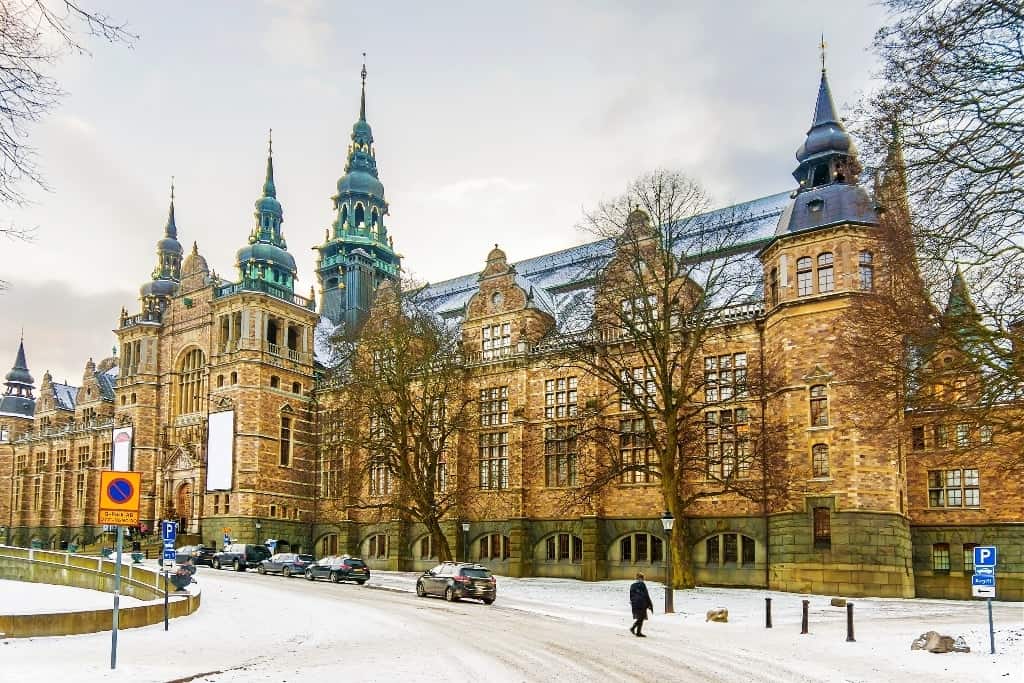
If it really is too cold to spend time outside there are a number of excellent museums in Stockholm. One of the most famous is the Vasa Museum, home to the Vasa warship, which sunk in the archipelago in 1628, only to be salvaged from the seabed over 300 years later. The ship was incredibly well preserved, making it a truly impressive and unique sight. Another of Stockholm’s best museums is the Nordic Museum. It is Sweden’s largest museum of cultural history and has many exhibitions about everyday life in Sweden throughout the ages.

A more modern experience can be had at Fotografiska (the museum of photography); a popular destination for tourists and Stockholmers alike. Aside from its world-class photography exhibitions, Fotografiska has an excellent cafe, restaurant and bar, with stunning views across the water to the north. At weekends there is a highly-recommended brunch buffet, with seasonal, plant-based dishes and a noteworthy dessert table.
Fika
Fika (meaning a coffee and cake break) is a Swedish institution at any time of year, but is particularly important in winter, not least because there are several days dedicated to certain types of cake throughout the winter months. The first is cinnamon bun (kanelbullar) day, celebrated on October 4. Then comes Lucia, the festival of lights, on December 13, which is celebrated with saffron buns (lussekatter). Christmas brings an abundance of gingerbread (pepparkakor), typically enjoyed with a type of mulled wine (glögg) replacing the usual coffee. After Christmas, in February, is Shrove Tuesday, meaning February and March are awash with cream and marzipan filled buns (semlor). Whatever the month, for any visitor it is important to fika often, as there is nothing more satisfyingly Swedish than cosying up in a warm cafe with a hot cup of coffee and home-made cake.
Where to eat in Stockholm during winter
Christmas buffets and Swedish food
From the end of November until Christmas, many restaurants serve traditional Christmas buffets (julbord). This typically comprises of pickled herring, white fish, salmon, meatballs, beetroot salad, cheeses, sausages, and ham. While there are restaurants all over that serve excellent julbords, Fjäderholmarnas Krog, provides the opportunity to combine a trip to the archipelago with a Christmas dinner. With stunning scenery, a glowing fireplace and an extensive buffet, it is the ultimate in luxury Swedish Christmas dining experiences.
While the traditional julbord is not so vegetarian-friendly, there are some restaurants with excellent vegetarian alternatives. Hermans is a vegetarian restaurant worth visiting any time of year, but which has a delicious range of vegetarian and vegan foods on its julbord. The restaurant itself sits high on a hill overlooking the water across Stockholm and is situated on one of the oldest streets in the city, giving the feeling of stepping back in time.
Seafood is a big part of Swedish cuisine and Stockholm Fisk is one of the best Seafood restaurants in the city. At Christmas they serve a huge seafood buffet, however, the menu is excellent all year round. For more of a hearty Swedish dish, Pelikan, located in a one-hundred-year-old beer hall, is a good option, serving classic dishes such as meatballs and mashed potato as well as Västerbotten cheese pie. A more sophisticated alternative is Fem Små Hus, located in the vaulted cellars of Gamla Stan, serving Swedish cuisine with a touch of French inspiration. It also has a small, stylish bar, perfect for a pre-dinner drink or two.
Another superb winter location for lunch, dinner or just a coffee or a few drinks, is Orangeriet, located by the edge of the water on Kungsholmen. There is a more formal restaurant in the same location (Trattorian), but the casual bar, which also serves food, is one of the coziest winter spots in Stockholm, with a huge fireplace in the center of the room, surrounded by comfy armchairs covered with cushions, overlooking the frozen lake.
Where to stay in Stockholm
Stockholm is relatively small and it is possible to travel across the inner city in around half an hour using public transport, so choosing which area to stay in is really just a matter of taste and budget. For a bit of luxury, some of the best waterside views and a central location, Grand Hotel is the ideal choice. Aside from the spa, Grand Hotel is also home to award-winning Swedish chef Mathias Dahlgren’s Michelin-starred, modernbistro Matbaren and his more recently opened, vibrant vegetarian restaurant Rutabaga.
Click here to check the latest prices and to book a room.
The boutique-style Lydmar Hotel is also centrally located and overlooks the water across to the Royal Palace. It has a comfortable-but-luxury feel and quirky-yet-stylish interior design. On Sundays there is a DJ in the restaurant/lounge area, creating a laid-back vibe and an enjoyable way to while away the afternoon.
Click here to check the latest prices and to book a room.
On the other side of town, in the hipster hotspot of Södermalm, is Hotel Rival, owned by ABBA’s Benny Andersson and with subtle nods to this throughout. The hotel also boasts several fashionable bars and a lively cafe.
Click here to check the latest prices and to book a room.
Despite Stockholm’s high prices, there is also more budget accommodation available, including several options that provide something a bit different from the usual hotel experience, such as one of the boat hostels moored along the side of the lake Mälaren, each with stunning views across the city. There is also a hostel and hotel situated inside the old prison on the island of Långholmen, which includes a restaurant and a museum exhibiting the 250 year history of the prison, which closed in 1975.
Click here to check the latest prices and to book a room.
What to pack for Stockholm in winter
As the Swedes say, “there’s no such thing as bad weather, only the wrong clothes,” however a large suitcase might be necessary for a winter trip to Stockholm, filled with winter boots, a warm coat, hat, gloves, scarf, thick socks and many, many layers to deal with changeable weather and going from the extremely-warm indoors to the freezing-cold outdoors. The streets get slushy and icy during the winter so it pays to have sensible shoes; something with a soft rubber sole typically works best to avoid sliding around too much, particularly on the cobbled streets of Gamla Stan. Swedes manage to stay stylish while protecting themselves against the winter weather, with a wool coat and black boots being pretty standard for men and women and recommended for those wanting to fit in with the crowd.
One important point to bear in mind when traveling in winter is that while the local authorities are typically very good at keeping public transport running, with an army of snowplows and gritting machines, there are rare occasions when airports are closed and buses and trains don’t run. This is usually only if there is unexpectedly heavy snow, but it pays to have some contingency time built into travel plans, particularly if traveling in early winter.
No one makes winter feel as cozy and sophisticated as the Swedes. So for anyone who is excited by the idea of the orange glow of the candles contrasted against the cold blue of the icy lakes, then Stockholm is the ultimate winter travel destination.
Laura is a Nordics-obsessed Brit currently living in Sweden where she writes about reindeer and kanelbullar. You can find her on instagram @stockholmsoul

